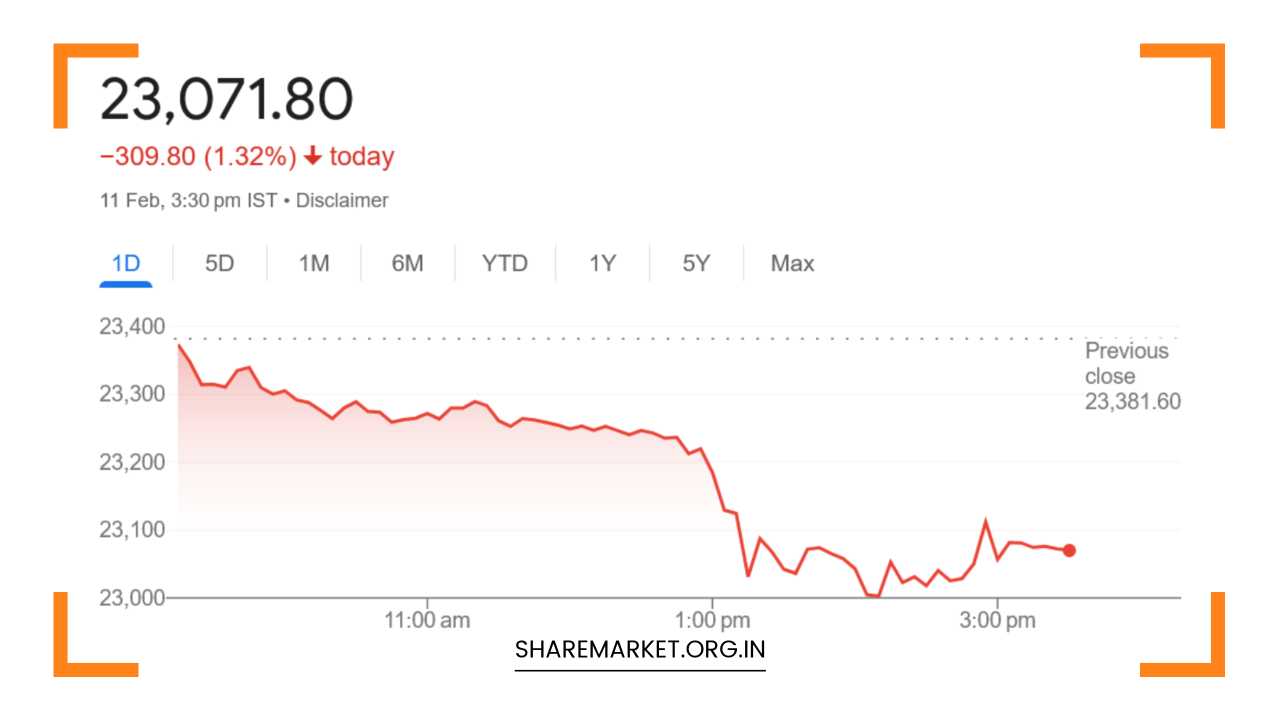Sensex Down 1,018 Points, Nifty at 23,071; Tomorrow Nifty Prediction

Tomorrow Nifty Prediction
Market Faces Fifth Consecutive Decline: What’s Next for Indian Stock Markets on February 12?
Share Market Update: Indian equity markets faced another day of sharp losses, marking the fifth consecutive trading session of declines.
On February 11, both the Nifty and Sensex ended the day in the red, as investor sentiment remained subdued amid ongoing global and domestic uncertainties.
The Nifty index closed below the critical psychological level of 23,100, reflecting persistent pressure on broader market indices.
The Sensex finished at 76,293.60, down by 1,018.20 points, or 1.32%, while the Nifty settled at 23,071.80, declining by 309.80 points, or 1.32%. This marks a troubling continuation of the downward trend, leaving investors on edge.
In terms of market breadth, there was a sharp imbalance between advancing and declining stocks. A total of 516 stocks advanced, but a staggering 3,330 stocks ended lower, with only 92 stocks remaining unchanged.
This heavy selling pressure indicated a broad-based retreat, with key sectors across the board facing losses.
The day’s biggest losers on the Nifty were Apollo Hospitals, Eicher Motors, Shriram Finance, Coal India, and Bharat Electronics, each suffering significant declines.
Conversely, the largest gainers included Adani Enterprises, Trent, Bharti Airtel, and Grasim Industries, though the positive moves in these stocks were insufficient to offset the widespread losses.
Sectoral Performance: The selling pressure was felt across all sectoral indices, with every segment closing in the red.
The auto, consumer durables, capital goods, oil and gas, energy, FMCG, healthcare, power, PSU, and real estate sectors all recorded losses in the range of 2-3%.
The Nifty Midcap index was hit particularly hard, slumping by 3%. More concerning was the performance of the Smallcap index, which saw a steeper decline of 3.5%, signaling that broader market participation was weak.
The negative momentum in mid- and small-cap stocks reflects growing concerns about valuations, future growth prospects, and increased selling from institutional investors.
The real estate and media sectors saw some of the sharpest declines, with both sectors bearing the brunt of negative sentiment.
Real estate stocks were hit by worries about higher borrowing costs, while the media sector struggled with concerns related to advertising revenue growth, which is expected to remain under pressure due to slowing economic activity.
Expert Insights on Market Outlook: Aditya Gaggar, Director at Progressive Shares, shared a detailed analysis of the market’s performance, pointing out that after a slow start, the bears made a strong comeback, driving the market lower.
Gaggar explained that today’s sharp decline saw the Nifty briefly dip below its psychological support level of 23,000.
This triggered a sense of fear among market participants, but the index managed to recover slightly by the end of the session, closing at 23,071.80.
Despite the recovery, the technical outlook for the market remains weak, with consistent selling pressure on every attempt at a bounce.
Gaggar also highlighted the broader market’s underperformance, particularly in the mid-cap and small-cap segments.
Both indices were hit hard, reflecting a sell-off in stocks that had previously been considered overvalued or at risk due to declining demand.
The midcap index fell by 3.02%, while the smallcap index declined by 3.45%, further indicating that the pain was widespread across the market. Gaggar mentioned that the immediate support level for the Nifty lies at 22,800.
If this level is breached, the next possible support level could be 22,600. Resistance on the upside is expected around the 23,240 mark, a level that will likely cap any upward movements in the near term.
Vinod Nair, Research Head at Geojit Financial Services, provided a broader perspective on the market’s current struggles, noting that sentiment continues to weaken due to a combination of global and domestic factors.
The uncertainty surrounding US trade policy and tariffs has been a significant drag on market sentiment, as investors remain cautious about the potential impact on global growth.
Nair also pointed out that concerns about domestic economic growth are heightening, as the country faces challenges such as inflationary pressures and lower-than-expected GDP growth figures. This has created a volatile environment in which investor confidence is fragile.
One of the critical drivers of the current market weakness is the continuous selling by Foreign Institutional Investors (FIIs), who have been net sellers in recent sessions.
Their sustained exit from the Indian markets has been a key concern for investors, as FIIs have historically played a vital role in supporting the market.
Nair also noted the sharp decline in mid- and small-cap stocks, driven by a combination of high valuations and demand concerns.
These segments had seen strong growth over the past few years but are now facing a reality check as investors reassess their future growth prospects.
Despite the ongoing weakness, Nair observed that the Indian rupee had shown some signs of recovery from its record lows, aided by interventions from the Reserve Bank of India.
However, the currency remains under pressure, reflecting broader concerns about the country’s economic outlook and its impact on inflation and trade balances.
This continued weakness in the rupee is likely to exert further pressure on the equity markets, especially as foreign investors may become more hesitant to invest in a volatile currency environment.
Looking Ahead: As market volatility continues, investors should prepare for a choppy ride in the near term.
The overall market sentiment remains fragile, with uncertainties in both global trade dynamics and domestic economic conditions weighing heavily on investor confidence.
For the Indian stock market, a key factor to watch is Prime Minister Modi’s upcoming visit to the United States, where discussions on trade and economic cooperation could offer some relief if they yield positive outcomes.
This visit may be seen as an opportunity to ease some of the trade-related tensions that have been causing concern in the markets.
Additionally, market participants will be closely monitoring upcoming US inflation data, which could provide clues about the Federal Reserve’s monetary policy stance.
Any signals of tighter monetary conditions in the US could further weigh on global risk assets, including Indian equities.
As the global economy faces potential slowdowns, investors will need to remain cautious and agile in their decision-making.
In summary, the Indian stock market faces continued headwinds in the short term, with weakening sentiment due to global uncertainties, domestic economic concerns, and continued selling by institutional investors.
The broader market, especially mid- and small-cap stocks, remains under pressure, and technical indicators suggest that the Nifty could test lower support levels in the coming days.
Traders and investors should stay alert, manage risk carefully, and remain watchful of key economic data and geopolitical developments that could shape market direction.

















